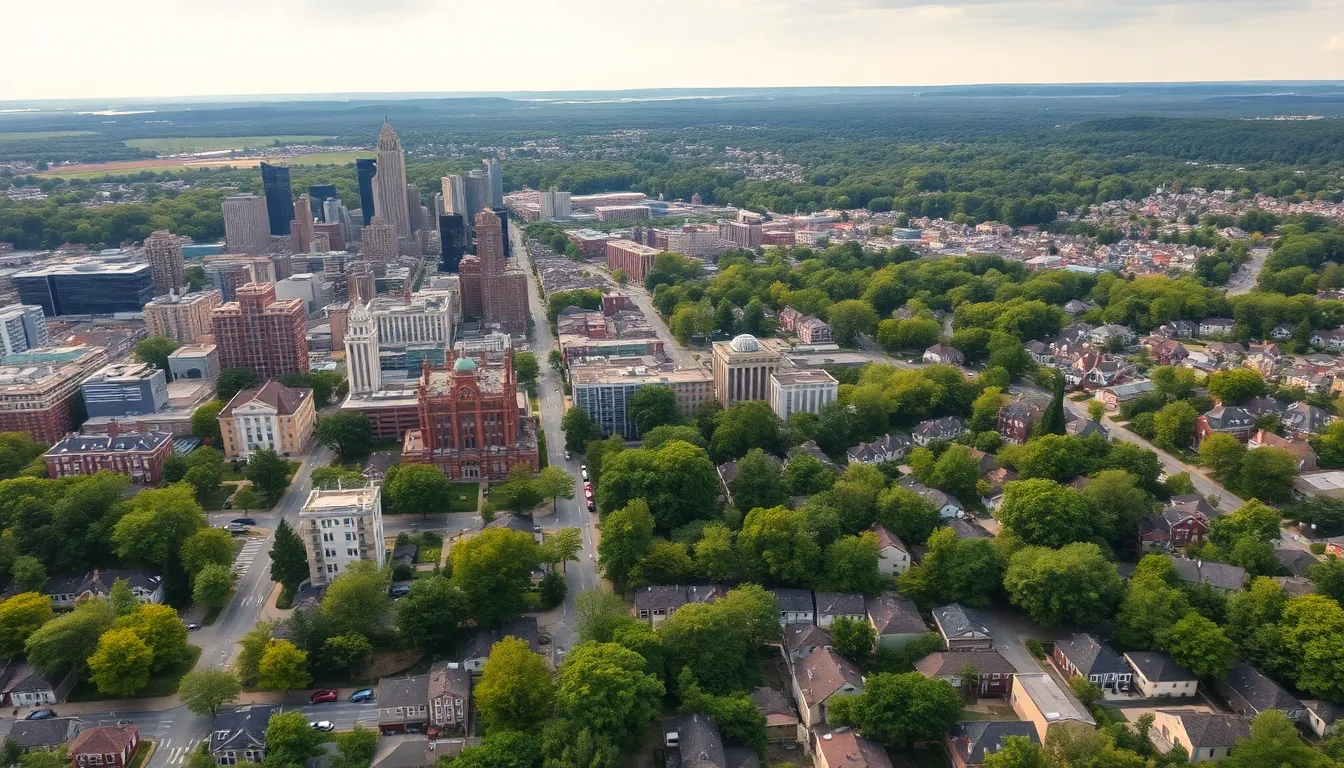Pennsylvania, known for its rich history and diverse landscapes, is home to millions of residents. As one of the original thirteen colonies, it has played a significant role in shaping the United States. With its bustling cities, charming small towns, and vibrant communities, the state offers a unique blend of urban and rural living.
Understanding the population of Pennsylvania provides valuable insights into its cultural and economic landscape. From the historic streets of Philadelphia to the scenic beauty of the Appalachian Mountains, the state’s demographics reflect a mix of traditions and modern influences. In this article, we’ll explore the current population figures and what they mean for the state’s future.
Table of Contents
ToggleOverview of Pennsylvania’s Population
Pennsylvania’s population stands at approximately 13 million residents, making it the fifth-most populous state in the United States. This number reflects the state’s diverse demographics, fueled by urban centers like Philadelphia and Pittsburgh, as well as rural communities throughout the Appalachian region.
Population density varies significantly across the state. Philadelphia, the largest city, has a density of about 11,400 people per square mile, while rural areas might host fewer than 100 residents per square mile. This blend contributes to a rich cultural tapestry, with significant Hispanic, African American, and immigrant communities adding to the state’s diversity.
Age distribution in Pennsylvania shows a median age of around 40.5 years, indicating an aging population. Of the total residents, approximately 16% fall within the senior demographic, aged 65 and older. This demographic shift emphasizes the importance of addressing health care, social services, and workforce implications.
Educational attainment in Pennsylvania is noteworthy, with about 87% of adults aged 25 and older holding a high school diploma and nearly 30% possessing a bachelor’s degree or higher. This educated workforce supports various sectors, enhancing the state’s economic landscape.
The population trends indicate a slow growth rate of 0.4% annually, influenced by factors such as migration patterns and birth rates. Urban migration has increased, as residents seek opportunities in metropolitan areas, impacting both housing markets and local economies.
Future predictions suggest a continued evolution of Pennsylvania’s population dynamics. With ongoing immigration and shifting birth rates, the state faces both challenges and opportunities in adapting to its changing demographic landscape.
Historical Population Trends

Pennsylvania’s population history reflects significant changes influenced by migration, economic shifts, and urbanization. Understanding these trends provides insights into the state’s cultural and demographic evolution.
Early Settlement Period
Early settlement in Pennsylvania began in the 1680s, led by William Penn and diverse groups seeking religious freedom. The population grew steadily, reaching approximately 200,000 by 1750, primarily composed of English, Welsh, and German immigrants. Rural communities flourished, with agriculture driving the economy. By the 1800s, the population surged past 1 million, fueled by further waves of immigrants, including Italians and Eastern Europeans, who settled in urban areas for industrial job opportunities.
Recent Growth Patterns
Recent population trends indicate a slow annual growth rate of 0.4%, with current estimates around 13 million. Urban centers like Philadelphia and Pittsburgh attract residents, while rural areas face population stagnation or decline. The state has experienced a shift toward suburban living, with many relocating from cities for larger homes and better amenities. Changes in birth rates and immigration patterns also impact demographics, as younger populations seek opportunities elsewhere, shaping the future growth landscape of Pennsylvania.
Demographic Breakdown
Pennsylvania’s demographic landscape reflects its complexity, shaped by various factors such as age distribution and ethnic diversity.
Age Distribution
The age distribution in Pennsylvania shows a median age of approximately 40.5 years. About 16% of residents are aged 65 and older, indicating a significant aging population. The state has a youth population as well, with approximately 21% aged 18 and younger. The 18 to 34 age group comprises roughly 14% of the population, while individuals aged 35 to 64 account for about 49%. This distribution underscores the importance of targeted programs for seniors and youth services.
Ethnic Diversity
Pennsylvania’s ethnic diversity is notable. The population includes approximately 76% White, 12% Black or African American, 6% Hispanic or Latino, and about 3% Asian. Communities in urban areas like Philadelphia and Pittsburgh showcase vibrant multicultural environments. These demographics promote a rich tapestry of cultural inputs influencing local traditions, cuisines, and educational systems. The state’s diversity drives economic growth and social cohesion, impacting community programs and policies.
Population Density by Region
Population density in Pennsylvania reflects a stark contrast between urban and rural areas, impacting community services and infrastructure.
Urban vs. Rural Areas
Urban areas in Pennsylvania exhibit high population density, with cities housing significant numbers of residents. Philadelphia, as the largest city, boasts a density of about 11,400 individuals per square mile. Pittsburgh follows with a density of around 5,100 people per square mile. In contrast, rural regions typically display much lower density, often with fewer than 100 residents per square mile. This disparity highlights the challenges faced by rural areas, including access to healthcare and job opportunities, while urban centers confront issues like congestion and housing demand.
Key Cities and Their Populations
Several key cities in Pennsylvania play pivotal roles in the state’s demographics. Below is a breakdown of major cities and their populations:
| City | Population | Population Density (people/sq mile) |
|---|---|---|
| Philadelphia | ~1.6 million | 11,400 |
| Pittsburgh | ~300,000 | 5,100 |
| Allentown | ~121,000 | 3,800 |
| Erie | ~94,000 | 4,100 |
| Reading | ~95,000 | 3,100 |
These cities significantly contribute to Pennsylvania’s overall population dynamics, fostering diverse economic and cultural landscapes.
Impacts of Population Changes
Population changes in Pennsylvania affect various aspects of life, including economics, social services, and infrastructure. Understanding these impacts is crucial for addressing the evolving needs of residents and the state’s growth.
Economic Implications
Economic growth in Pennsylvania correlates closely with population dynamics. Population density directly affects the labor market, influencing job availability and wage levels. Urban areas like Philadelphia and Pittsburgh experience job growth due to higher population concentrations, often attracting businesses and investors. In contrast, rural areas face challenges such as declining job opportunities and slower economic development.
Shifts in demographic trends lead to changes in consumer behavior. An aging population necessitates more healthcare services, impacting local economies. Furthermore, educational attainment influences workforce skills, with 30% of adults holding a bachelor’s degree or higher, offering businesses a skilled labor pool. Economic policies must adapt to address these population-driven trends, ensuring sustained growth and competitive advantage.
Social Services and Infrastructure
Evolving population dynamics necessitate an examination of social services and infrastructure within Pennsylvania. With approximately 16% of residents aged 65 and older, the demand for healthcare, transportation, and social support services increases significantly. Addressing such needs requires strategic planning and allocation of resources.
Infrastructure development varies dramatically between urban and rural areas. Urban centers, with a denser population, experience higher demands for transportation, housing, and public services, presenting challenges such as congestion and resource allocation. Conversely, rural areas often face underfunded infrastructure and limited access to essential services.
Adapting social services and infrastructure to meet the changing demographics involves investing in public transportation, healthcare facilities, and community programs. Targeting resources toward educational initiatives also enhances social well-being, ensuring that the state meets the diverse needs of its population.
Pennsylvania’s population of approximately 13 million reflects a unique blend of urban and rural dynamics. The state’s demographic diversity is evident in its age distribution and ethnic backgrounds. As the population continues to evolve at a slow growth rate, both challenges and opportunities emerge for community services and infrastructure. Understanding these trends is crucial for addressing the needs of residents and fostering a vibrant future. The rich cultural tapestry of Pennsylvania not only shapes its identity but also plays a significant role in its economic landscape. By adapting to demographic shifts, the state can enhance the quality of life for all its residents.


